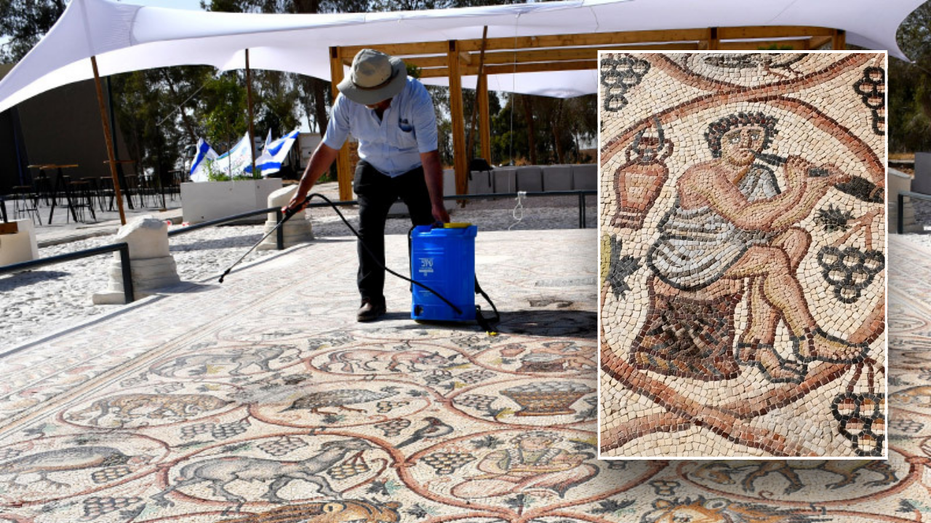A stunning mosaic estimated to be around 1,600 years old has been unveiled, shedding light on its fascinating history and rich cultural significance. This remarkable piece, discovered in a Christian monastery, has remained obscured for centuries, waiting to tell its story to the world.
The mosaic, adorned with intricate designs and vibrant colors, was uncovered during archaeological excavations in a region known for its religious heritage. Once thought lost to time, the mosaic offers a glimpse into the artistic capabilities and spiritual life of early Christians.
Experts believe the mosaic was originally part of a larger floor design within the monastery, showcasing scenes from Biblical texts and symbols representative of Christian faith. The craftsmanship displayed in its creation suggests that it was designed by skilled artisans of the period, highlighting the importance of this religious site.
Historians and archaeologists have long been captivated by the relationship between art and religion in early Christian communities. The techniques used in the mosaic, including the careful selection of colored stones and the precision of its layout, reflect the spiritual devotion of the time. Each piece of tesserae—small stones used to create the mosaic—was meticulously placed to form depictions that likely held deep significance for the faithful who worshipped here.
The revelation of this mosaic comes at a time when interest in early Christian art is resurging. The piece not only adds to the understanding of artistic practices during the late Roman Empire but also enriches the narrative surrounding early Christian life. Researchers are eager to analyze and preserve the mosaic, ensuring that it can endure for future generations to appreciate.
The excavation site, which was once a thriving community hub, indicates that the monastery was likely a focal point for religious education and social gatherings. The discovery of the mosaic contributes to this narrative, suggesting that the artistic endeavor might have been intended to inspire those who walked upon it. Its aesthetic beauty would have been not only a feast for the eyes but also a medium to convey spiritual truths.
As archaeologists carefully removed layers of soil and debris, the colors and patterns of the mosaic began to emerge, much to the excitement of the team. Each discovery made during the unearthing of the site has provided insights into the daily lives of the people who once inhabited this region. Moreover, the imagery found in the mosaic is expected to link it to other similar artworks from the same era, offering connections between historical practices and beliefs shared across regions.
Onlookers are struck by the fact that this mosaic has, until now, remained largely hidden from view. The team responsible for the excavation has expressed their amazement that such a well-preserved piece could exist in a world where many artifacts have succumbed to the ravages of time.
The unveiling of the mosaic is not just a victory for archaeologists but also for cultural heritage advocates who argue for the importance of preserving historical sites. This discovery emphasizes the need to protect archaeological sites from modern development and encroachment, reminding society of the wealth of history that lies beneath our feet.
As more excavations continue to take place in the area, it is likely that additional treasures will be uncovered, further enhancing our understanding of early Christian culture. The researchers are optimistic that the detailed study of the mosaic can offer new revelations about the relationship between art, faith, and community in antiquity.
While the mosaic captures the imagination of scholars and enthusiasts, it is also a poignant reminder of the enduring nature of faith and artistry across the centuries. As visitors flock to witness this artistic gem, they are provided an opportunity to reflect on the connections that bind generations through shared beliefs and cultural expressions.
The site where the mosaic was found is expected to become a point of interest for both tourists and researchers alike. Plans are already underway to make it accessible to the public, allowing the wider community to appreciate the beauty of the mosaic and the history it represents.
The reactions from the local community have been overwhelmingly positive, with many expressing pride in their heritage and eagerness to learn more about the region’s past. Educational initiatives are being considered to help engage local schools in discussions about archaeology and the significance of the discoveries made in their own backyard.
Authorities are also discussing potential collaborations with museums to properly showcase the mosaic and other artifacts from the excavation site. Such efforts aim to foster a greater appreciation for cultural heritage and ensure that the local history is preserved and celebrated.
Through this discovery, the mosaic stands not only as a testament to the artistic achievements of the ancient world but also as a bridge connecting the past with the present. It allows people today to engage with their history in profound ways, reminding them that the stories of those who walked before us continue to resonate across time.
As we delve deeper into the mysteries of our past, instances like these serve as an important reminder of the human experience’s remarkable continuity. The unveiled mosaic invites reflection on faith, creativity, and the cultural tapestry that defines our shared humanity.
In closing, the unveiling of this ancient mosaic marks a significant milestone in the study of early Christian art and history. It is a reminder of the incredible stories waiting to be uncovered and the importance of preserving our collective past for future generations. As we continue to uncover the treasures of history, we are left enriched by the insights they provide into how art and belief interweave to shape our world.
































